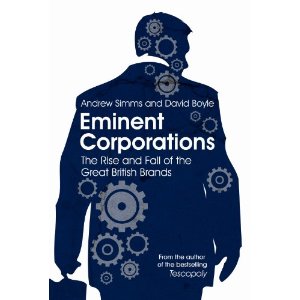(East India Company, Barclay’s, Rover, BP, Virgin, BBC, Marks & Spencer, Cadbury’s)
|
Constable & Robinson (2010) by Andrew Simms and David Boyle |
 |
|
| Book details | ||
| Buy the book | ||
In the week that the banks failed – that strange week in October 2008, where everything seemed to be unravelling – I ventured into the City Business Library, in its familiar, slightly unkempt building off London Wall.
I used to spend quite some time there, when I was writing about the history of money. I remembered it – perhaps wrongly – as a font of hidden knowledge. By 2008, it certainly wasn’t that.
Where were those decades of back issues of obscure American business magazines? Where were those strange 1960s books of business predictions?
I asked at the desk and was informed that it was the library’s policy to dispose of most material after three years, and all of it after five years.
It was rather a strange discovery. Wall Street and the City of London had allowed the banking system to collapse because their risk software had little or no memory beyond ten years – barely longer than the business cycle.
Most of those taking day to day decisions about risk in the City were in their twenties and had little memory of the great rises and falls of the market. Their lack of history had hampered their ability to see events for what they really were.
I don’t suppose the City Business Library’s decision to bin anything dog-eared contributed to this historical vacuum – it was symptom not cause.
Nor was the last government’s strange blindness to history (heritage was one of the only areas of government funding to go down under New Labour), but neither of these can have helped.
Yet the excision of history from business commentary and corporate life – and its replacement by marketing mush – was definitely one of the major causes of the current miserable economic climate.
There is a bigger problem here about business history. There are obscure tomes of corporate history which only academics read, and there are cursory notes – written by marketing departments – that appear on websites. Otherwise that’s it.
The great corporations are treated as if they were people in courts of law. They have similar rights to us. But in other ways they are very unlike real human beings indeed – they have no emotions, often no morals, and worst of all they have no life histories.
We live in an age where the PLC is almost the proudest institution on earth. But actually, seen through an historical perspective, they are flimsy, fragile, insubstantial things, which flower briefly and then disintegrate into their constituent bits – a few brands there, a vice-president here, an office block again there. More like multinational mayflies than megacorps.
Yet because there are no histories of these corporations, no back stories, no roots – we let them control our lives with stories about them conjured out of the air by whatever director of marketing they last employed.
The result is our strange, one-dimensional view of corporations. We suffer under the delusion that the great names of corporate power – Coca-Cola, Procter & Gamble, Wal-mart – were knocked together by God some time on Day Six of the creation of the world.
We don’t know where they came from; we don’t know why. We don’t know what they really are.
So it occurred to my colleague Andrew Simms and I that what the big brands needed was a dose of what Lytton Strachey did for his Eminent Victorians – an experimental new kind of mini-biography.
Like the Victorian giants, we have an absolute avalanche of information about the corporations that dominate our lives – rather as Strachey and his Edwardian friends did about the giants of the Victorian age – but very little actual knowledge.
Following in Strachey’s footsteps is high risk. He was one of the great stylists of the past century. Andrew and I are not really in his class.
But somebody had to try applying his approach to our Eminent Corporations. I hope people who deserve Strachey’s mantle a little more will carry on where we left off.
